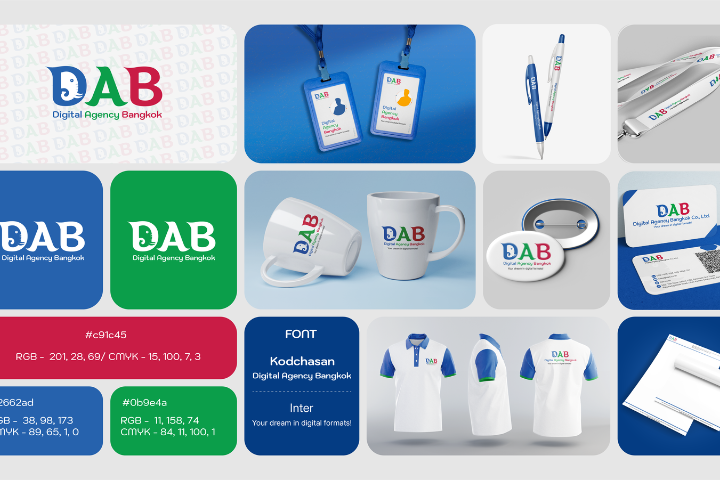How to Rebrand Your Business 5 Key Steps You Need to Know

Every business reaches a point when its current brand no longer meets market needs. Changes in target customers, increased competition, or an outdated brand image are all signs that it may be time to refresh your identity. Rebranding is a powerful tool to help your business become clearer and stand out. It involves adapting your brand across all areas, from CI and logo design to your website, content, social media, and digital marketing strategies, ensuring you reach your customers effectively.
In this article, we’ll explore what steps a business should take when rebranding, covering the importance of rebranding, 5 areas to update, how to check if your business needs a rebrand, and essential tips to ensure a smooth process, including when to consider hiring a professional agency for CI and branding design.
The Importance of Rebranding
Rebranding is more than just changing a logo or color palette. It’s a strategic process that allows a business to adapt to the current market and its target audience effectively. For established companies or those facing intense competition, rebranding is crucial. It helps convey a refreshed brand identity and clearly communicate your business values.
One key reason for rebranding is adapting to changing consumer behavior. For example, a cosmetics brand may initially target teenagers, but over time, its audience expands to include adults. Updating CI, logos, color schemes, and social media presence helps the brand remain relevant and reach new customer segments. Rebranding also strengthens credibility and customer confidence. Businesses with consistent branding across online and offline channels tend to be perceived as more professional than those using outdated CI or mismatched websites. Aligning CI, website design, and content creates a cohesive experience, showing customers that your brand is reliable and ready to serve.
A clear example is a restaurant that refreshes its branding. Along with updating its logo and main colors, it redesigns its website for usability, adds an online menu, and showcases attractive food images and reviews. This not only helps customers understand the brand and its offerings but also makes Facebook and Google Ads more effective by targeting the right audience.
In short, rebranding enables businesses to adapt to customer behavior, differentiate from competitors, and enhance brand credibility. Aligning CI, logo, website, and digital marketing ensures your brand communicates value effectively and builds a strong foundation for future growth.
5 Areas Businesses Should Update When Rebranding
1.CI / Logo / Brand Guidelines
Corporate Identity (CI) encompasses all elements that communicate your brand’s image and personality. Rebranding often begins with updating CI to align with your current business direction, including logo, colors, fonts, and visual symbols. A clear brand guideline ensures that both internal teams and external partners communicate your brand consistently.
A strong CI does more than look good—it helps customers recognize your brand easily and distinguishes you from competitors in a crowded market.
2.Website and Online Platforms
Your website is the central hub of your online presence. Rebranding often involves updating or redesigning your site to reflect the new brand identity, including design, content layout, color palette, typography, UX/UI, and loading performance. A modern, user-friendly website immediately conveys your brand’s values and professionalism.
Additionally, your website connects with digital marketing efforts like SEO, social media, and advertising campaigns. Aligning your website with the new CI directly impacts credibility and marketing effectiveness.
3.Content and Social Media
The tone and style of your content reflect your brand’s personality. When rebranding, review your messaging, images, videos, tone of voice, and storytelling methods to align with the new identity. Consistent and unique content writing helps customers recognize and remember your brand.
Tailoring content to each social media platform and target audience increases engagement and ensures your brand communicates effectively across channels.
4.Digital Marketing and Advertising
Rebranding should be aligned with your digital marketing strategies, including Facebook Ads, Google Ads, and email campaigns. Updating ad copy, visuals, and audience targeting is essential to communicate your new brand identity effectively and maximize campaign performance.
Consider customer insights and online behavior to refine your content and advertising strategy for optimal results.
5.Customer Experience and Brand Touchpoints
Every interaction a customer has with your brand should reflect your new identity, from documents, emails, and after-sales service to online channels. Creating a consistent experience demonstrates professionalism and leaves a lasting impression.
Evaluate document style, messaging tone, and organize all touchpoints to match your refreshed brand identity. Cohesive branding across every interaction builds trust and reinforces your brand’s credibility.
How to Check if Your Business Needs a Rebrand
Try this fun checklist from Digital Agency Bangkok. Simply answer each question with “Yes” or “No” to see if your brand may need an update. If you answer “Yes” to several questions, it may be time to consider rebranding:
- Your brand feels outdated – logo, colors, fonts, or overall style no longer match the current image
- Customers don’t clearly understand your brand – they cannot tell how your business differs from competitors
- Competitors stand out more – increased competition is overshadowing your brand
- Expanding to new markets or audiences is challenging – your current brand doesn’t communicate effectively with new customer groups
- Customer experience is inconsistent – online and offline touchpoints are misaligned, causing confusion
- Content and messaging don’t reflect the brand identity – text, images, or tone do not convey the intended brand message
- Your business needs to build credibility – the old brand may not reflect professionalism or your true value
Conclusion
Rebranding is a strategic process that refreshes your business identity to be clear, modern, and aligned with your target audience. It goes beyond logos or colors and encompasses CI, website design, content, digital marketing, and customer experience.
Determining whether to rebrand starts with evaluating if your current brand aligns with the market and customers. Using a simple checklist can help you decide if it’s time to update your brand. When done systematically, rebranding helps your business stand out, communicate clearly, and build long-term credibility—a critical step for sustainable growth.
Make Your Brand Stand Out with Digital Agency Bangkok
Successful rebranding or building a new brand requires a strong, comprehensive Corporate Identity (CI) that includes logo design, color schemes, typography, graphics, and consistent visual style across all channels.
At Digital Agency Bangkok, we have over 16 years of experience in CI and branding design. Whether creating a new brand or refreshing an existing one, we help businesses of all sizes communicate their brand identity clearly and uniquely.
Our services include:
- Logo and mascot design for brand recognition
- CI / brand guidelines to ensure consistent communication across all platforms
- Graphic and creative design for online and offline media
- Digital marketing strategy to reach the right audience effectively
Whether you’re rebranding or starting a new business, Digital Agency Bangkok can help your brand stand out, be memorable, and build trust with customers.
Contact us for a free consultation
Phone: 098-7655-243 or 098-7655-701
Email: [email protected]






